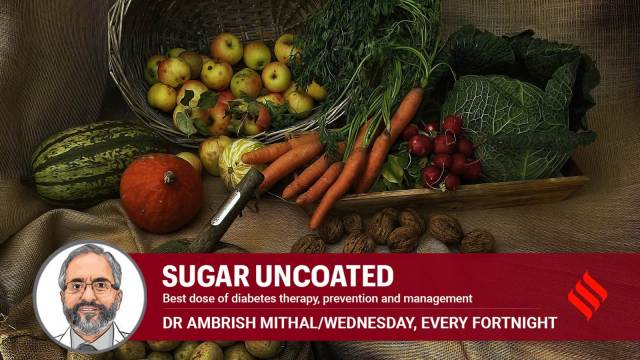How to rejig protein, carb and fat combo to control blood sugar: Here are a few tips
Dr Ambrish Mithal, Chairman and Head, Endocrinology and Diabetes, Max Healthcare, decodes the recent dietary guidelines by ICMR
 Eating healthy is about having balanced meals, including macronutrients and micronutrients from at least eight food groups. (Pixabay/File Photo)
Eating healthy is about having balanced meals, including macronutrients and micronutrients from at least eight food groups. (Pixabay/File Photo)People are often confused about healthy eating. The conflicting nutrition advice on the internet/social media surely does not help! But the recently-released “Dietary Guidelines for Indians” by the Indian Council of Medical Research (ICMR) provide scientific information about nutritious eating and prevention of non-communicable diseases (NCDs), including obesity, diabetes and heart disease.
Eating healthy is not about very low-calorie diets or eliminating a particular food group. Rather, it’s about having balanced meals, including macronutrients and micronutrients from at least eight food groups. Any one food cannot act as a superfood. Rather it is the balanced meal approach and inclusion of diverse foods that helps in the prevention and management of NCDs. According to the guidelines, 56.4 per cent of NCDs are due to faulty dietary habits. Eighty percent or more Type 2 diabetes would vanish if we could eat healthy and avoid obesity.
HOW TO MANAGE THE NUTRIENT PIE?
Vegetables, fruits, green leafy vegetables, roots and tubers should fill half of our plate. The ideal diet should limit cereals and millets to 45 per cent of calorie intake (actual intake currently ranges from 50-70 per cent), allocate 15 per cent of calories to pulses, beans, and meat (actual intake at 6-9 per cent) and source the remainder from nuts, vegetables, fruits and milk.
Avoid foods with high sugar, fat and those that are ultra-processed. These foods are depleted of fibre and nutrients and impact our health negatively.
HOW TO CUSTOMISE FOOD GROUPS
Carbohydrates: The trick is to eliminate refined carbohydrates like maida, refined flour and bran-free rice, and replace it with whole wheat, millets and rice with bran.
Fruits and vegetables: Fruits and vegetables are a rich source of vitamins, minerals, antioxidants, fibres and act like prebiotics. Indians have only 100 to 200 gm vegetable and fruits/day while the recommendation is 500 gm/day. Include seasonal greens, leafy vegetables and coloured vegetables in daily diet to meet the quota. Root vegetables like carrots, radish, knol knol and turnip should be preferred over tubers like potato, yam and colocasia. People who already have diabetes should limit their fruit intake to 30 gm daily, preferably divided into two servings containing 15 gm of carbohydrate each. Fruit juice is not recommended as it takes away the fibre and minerals and provides a large number of calories with a high glycemic index, or the rate at which blood glucose levels increase after consumption.
Fats: Include foods rich in polyunsaturated Omega 3 fatty acids (PUFA) such as nuts/oil seeds, soybeans, grains/millets, green leafy vegetables and fenugreek seeds. Marine fish like salmon, trout, mackerel and tuna provide long chain Omega 3 fatty acids, biologically more active than short chain fatty acids in plant foods. If one consumes adequate amounts of nuts, oilseeds, pulses and beans, the required amounts of Omega-3 and Omega 3 are easily met. Hence there is no nutritional need for extra oil/fat for cooking (visible fat). If impossible to avoid, we must ensure limiting visible fat to 4-10 tsp per person/day (depending on physical activity). It is advisable to limit or avoid ghee/butter. Limit ready-to-eat, bakery products that contain trans and saturated fats. Avoid repeated heating of oil.
Proteins: Maintaining higher muscle mass improves insulin sensitivity and decreases the risk of diabetes, stroke and heart attacks. Dietary protein is not used efficiently without adequate carbohydrates and fats or regular physical activity. The recommended dietary allowance is 0.83g protein per kg of body weight. The daily diet of an average adult should provide 60 to 70 g of protein. Plant diets, with a combination of cereals, pulses, nuts and seeds, can provide essential amino acids. Achieving optimum protein intake can be a challenge for those who avoid dairy completely. Eggs and lean meats provide high quality protein.






- 01
- 02
- 03
- 04
- 05

























